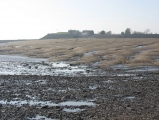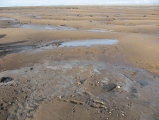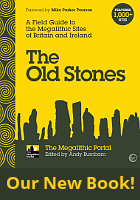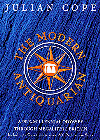<< Our Photo Pages >> Goldcliff East Mesolithic Site - Ancient Trackway in Wales in Monmouthshire
Submitted by SolarMegalith on Tuesday, 19 March 2013 Page Views: 23007
Mesolithic, Palaeolithic and EarlierSite Name: Goldcliff East Mesolithic SiteCountry: Wales County: Monmouthshire Type: Ancient Trackway
Nearest Town: Newport Nearest Village: Goldcliff
Map Ref: ST3771582063
Latitude: 51.534020N Longitude: 2.899358W
Condition:
| 5 | Perfect |
| 4 | Almost Perfect |
| 3 | Reasonable but with some damage |
| 2 | Ruined but still recognisable as an ancient site |
| 1 | Pretty much destroyed, possibly visible as crop marks |
| 0 | No data. |
| -1 | Completely destroyed |
| 5 | Superb |
| 4 | Good |
| 3 | Ordinary |
| 2 | Not Good |
| 1 | Awful |
| 0 | No data. |
| 5 | Can be driven to, probably with disabled access |
| 4 | Short walk on a footpath |
| 3 | Requiring a bit more of a walk |
| 2 | A long walk |
| 1 | In the middle of nowhere, a nightmare to find |
| 0 | No data. |
| 5 | co-ordinates taken by GPS or official recorded co-ordinates |
| 4 | co-ordinates scaled from a detailed map |
| 3 | co-ordinates scaled from a bad map |
| 2 | co-ordinates of the nearest village |
| 1 | co-ordinates of the nearest town |
| 0 | no data |
Internal Links:
External Links:
I have visited· I would like to visit
SolarMegalith visited on 10th Mar 2012 - their rating: Cond: 2 Amb: 4 Access: 2
The Mesolithic footprints are visible on exposed lamination beds, usually disturbing the lamination. Most of the footprints are in mediocre and poor condition. In 2001 total number of 61 footprints was recorded, among them 35 human footprints (some of them uncertain). The other footprints are bird (gull and crane) and reindeer ones. In some places they form footprint-tracks, couple of which were removed using block-lifting technique. On a foreshore in the nearby there are also remains of the trees from the Mesolithic submerged forest (one of the trunks was dated to 4100 BC) and Mesolithic occupation sites where flint tools (mainly microliths) were discovered.
The hill with remains of a priory which is located west from the foreshore sites is a former island. Remains of the Iron Age trackways were discovered in the nearby.
Reference:
Bell, M. et al. 2001. "Mesolithic to Neolithic coastal environmental change c. 6500-3500 cal BC". Archaeology in the Severn Estuary volume 12, p. 27-53.
Note: Two reports from the University of Reading research at Goldcliff East
You may be viewing yesterday's version of this page. To see the most up to date information please register for a free account.


Do not use the above information on other web sites or publications without permission of the contributor.
Click here to see more info for this site
Nearby sites
Key: Red: member's photo, Blue: 3rd party photo, Yellow: other image, Green: no photo - please go there and take one, Grey: site destroyed
Download sites to:
KML (Google Earth)
GPX (GPS waypoints)
CSV (Garmin/Navman)
CSV (Excel)
To unlock full downloads you need to sign up as a Contributory Member. Otherwise downloads are limited to 50 sites.
Turn off the page maps and other distractions
Nearby sites listing. In the following links * = Image available
2.2km NW 311° Goldcliff Earthwork Misc. Earthwork (ST361835)
4.9km W 276° Mesolithic Human Footprints at Uskmouth* Natural Stone / Erratic / Other Natural Feature (ST32808260)
5.7km ENE 69° Caldicot Level Ancient Trackway (ST431841)
6.6km NNE 30° Wilcrick Hill Fort* Hillfort (ST411877)
6.8km NNE 28° Wilcrick Wishing Well* Holy Well or Sacred Spring (ST4097088044)
7.1km N 3° Langstone (Bishton)* Round Barrow(s) (ST382891)
7.5km ENE 66° Upton Ancient Trackway Ancient Trackway (ST446850)
7.5km N 359° Lang Stone (Newport)* Standing Stone (Menhir) (ST37698961)
7.6km ENE 66° Chapel Tump Ancient Village or Settlement (ST447851)
8.0km NW 324° Maindee Camp Ancient Village or Settlement (ST3304588604)
8.0km NW 324° Maindy Hill Camp Misc. Earthwork (ST3304588604)
8.0km NNW 332° St Julian's Wood Hillfort (ST340892)
8.2km NE 50° Undy Earthwork Misc. Earthwork (ST441873)
8.6km N 4° Tre-Garn Round Cairn (ST384906)
8.7km NW 312° Newport Museum and Art Gallery* Museum (ST31278791)
8.8km NE 49° Llanfihangel Rogiet* Standing Stone (Menhir) (ST44518775)
9.2km NNW 336° Caerleon Roman Fortress and Baths* Ancient Village or Settlement (ST34039050)
9.4km NE 51° Llanfihangel Rogiet Churchyard Cross* Ancient Cross (ST4512087850)
9.4km N 360° Coed y Caerau* Ancient Village or Settlement (ST378915)
9.7km NE 34° The Larches Camp* Hillfort (ST433900)
9.8km NNE 32° Carrow Hill Round Barrow Pair Round Barrow(s) (ST42999029)
9.8km SSE 148° Walton-in-Gordano Banjo Enclosure* Misc. Earthwork (ST42847373)
9.8km ESE 117° Battery Point* Modern Stone Circle etc (ST46437756)
9.9km WNW 298° Tredegar Hillfort* Hillfort (ST290868)
10.0km SSE 160° Walton St Mary Cross Ancient Cross (ST4096172635)
View more nearby sites and additional images






 We would like to know more about this location. Please feel free to add a brief description and any relevant information in your own language.
We would like to know more about this location. Please feel free to add a brief description and any relevant information in your own language. Wir möchten mehr über diese Stätte erfahren. Bitte zögern Sie nicht, eine kurze Beschreibung und relevante Informationen in Deutsch hinzuzufügen.
Wir möchten mehr über diese Stätte erfahren. Bitte zögern Sie nicht, eine kurze Beschreibung und relevante Informationen in Deutsch hinzuzufügen. Nous aimerions en savoir encore un peu sur les lieux. S'il vous plaît n'hesitez pas à ajouter une courte description et tous les renseignements pertinents dans votre propre langue.
Nous aimerions en savoir encore un peu sur les lieux. S'il vous plaît n'hesitez pas à ajouter une courte description et tous les renseignements pertinents dans votre propre langue. Quisieramos informarnos un poco más de las lugares. No dude en añadir una breve descripción y otros datos relevantes en su propio idioma.
Quisieramos informarnos un poco más de las lugares. No dude en añadir una breve descripción y otros datos relevantes en su propio idioma.